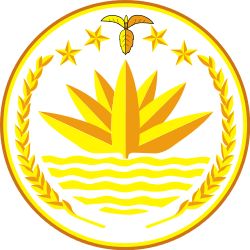Administrative geography of Bangladesh
| Subdivisions of Bangladesh | |||||||||||||||
|---|---|---|---|---|---|---|---|---|---|---|---|---|---|---|---|
 | |||||||||||||||
| Location | Bangladesh | ||||||||||||||
| Subdivisions |
| ||||||||||||||
 |
| This article is part of a series on the politics and government of Bangladesh |
| Constitution |
|
Legislature
|
|
Executive |
|
|
Political parties |
|
Foreign policy |
|
Politics portal |
Bangladesh is divided into 7 Divisions (Bibhag) and 64 Districts(Jela, Zila, Zela), although these have only a limited role in public policy. For the purposes of local government, the country is divided into Upazila, Thana and Union Council. The diagram below outlines the five tiers of government in Bangladesh.
| Central government | |||||||||||||||||||||
| Division | |||||||||||||||||||||
| District | |||||||||||||||||||||
| Subdistrict | |||||||||||||||||||||
| Union Council (Rural area) | Cities (Urban area) | Municipalities (Suburb) | |||||||||||||||||||
Divisions
Bangladesh is divided into seven major administrative divisions (Bengali: বিভাগ Bibhag). Each division is named after the major city within its jurisdiction that serves as the administrative capital of that division:
- Barisal (বরিশাল Borishal)
- Chittagong (চট্টগ্রাম Chôţţogram)
- Dhaka (ঢাকা Đhaka)
- Khulna (খুলনা Khulna)
- Rajshahi (রাজশাহী Rajshahi)
- Rangpur (রংপুর Rongpur)
- Sylhet (সিলেট Silet)
Regions
Formerly Bangladesh was also divided into 21 regions, which formed an additional administrative level between the levels of the divisions and the districts:
- Bandarban region
- Barisal region
- Bogra region
- Chittagong region
- Chittagong Hill Tracts
- Comilla region
- Dhaka region
- Dinajpur region
- Faridpur region
- Jamalpur region
- Jessore region
- Khulna region
- Kushtia region
- Mymensingh region
- Noakhali region
- Pabna region
- Patuakhali region
- Rajshahi region
- Rangpur region
- Sylhet region
- Tangail region
Districts
The divisions are divided into 64[2] districts, or zila (Bengali: জেলা jela). Each district is run by a Deputy Commissioner (popularly abbreviated to "DC") who is appointed by the government from a Deputy secretary of B.C.S. Administration Cadre.
| Division | Number | Districts |
|---|---|---|
| Barisal Division | 6 | |
| Chittagong Division | 11 | |
| Dhaka Division | 17 | |
| Khulna Division | 10 | |
| Rajshahi Division | 8 | |
| Rangpur Division | 8 | |
| Sylhet Division | 4 | |
| Total | 64 |
Subdistricts
The districts are divided into subdistricts called Upazila (Bengali উপজেলা upojela). Upazilas are similar to the county subdivisions found in some Western countries. At present Bangladesh has 488 upazilas. The Local Government Ordinance of 1982 was amended a year later, redesignating and upgrading many existing thanas as upazilas.[3]
Local level
City Corporations
The cities with a city corporation, having mayoral elections, include Dhaka South, Dhaka North, Chittagong, Khulna, Sylhet, Rajshahi, Barisal, Rangpur, Comilla and Gazipur. The city corporation are divided into wards, which are further divided into mahallas. Direct elections are held for each ward, electing a councillor. The city mayors are elected for a span of five years.
Municipal Corporations
In the metropolitan areas, excluding the cities with city corporations, have municipal corporations, also known as Pourashava. Pourashavas are divided into wards, which are further divided into Mauzas and Mahallas. Direct elections are held for each ward, electing a chairperson and a number of members. The municipal heads are elected for a span of five years.
| Division | Number | Municipalities |
|---|---|---|
| Barisal Division | 6 |
|
| Chittagong Division | 16 |
|
| Dhaka Division | 16 |
|
| Khulna Division | 9 |
|
| Rajshahi Division | 7 | |
| Rangpur Division | 8 | |
| Sylhet Division | 5 |
|
| Total | 67 |
Union Councils
Union Councils (or Union Parishads or Town Unions or Unions) are the smallest rural administrative and local government units in Bangladesh.[4] Each Union is made up of nine Wards. Usually one village is designated as a Ward. There are 4,550 Unions in Bangladesh.[1] A Union Council consists of a Chairman and twelve members including three members exclusively reserved for women. Union Parishads are formed under the Local Government (Union Parishads) Act, 2009.[5] The boundary of each Union is demarcated by the Deputy Commissioner of the District. A Union Council is the body primarily responsible for agricultural, industrial and community development within the local limits of the union.
Lowest level
Villages
Mahallas
Wards
Mouzas
References
- ↑ 1.0 1.1 http://www.bangladesh.gov.bd/?q=en
- ↑ http://www.bangladesh.gov.bd/index.php?option=com_content&task=view&id=225&Itemid=272
- ↑ Kamal Siddiqui. "Local Government". In Sirajul Islam. Banglapedia: National Encyclopedia of Bangladesh. Asiatic Society of Bangladesh. Retrieved 9 July 2013.
- ↑ Khan, Dr. Mohammad Mohabbat. "Functioning of Local Government (Union Parishad): Legal and Practical Constraints" (PDF). Democracywatch. Retrieved 24 March 2012.
- ↑ "Local Government (Union Parishads) Act, 2009 (in Bangla).". Bangladesh Code. Ministry of Law, Government of Bangladesh.
See also
- Divisions of Bangladesh
- Districts of Bangladesh
- Upazilas of Bangladesh
- Unions of Bangladesh
- Villages of Bangladesh
| ||||||||||||||